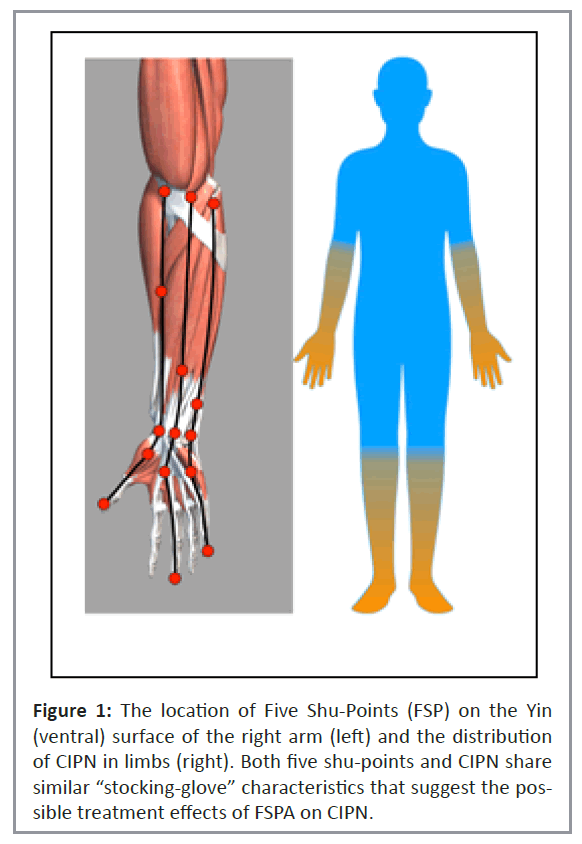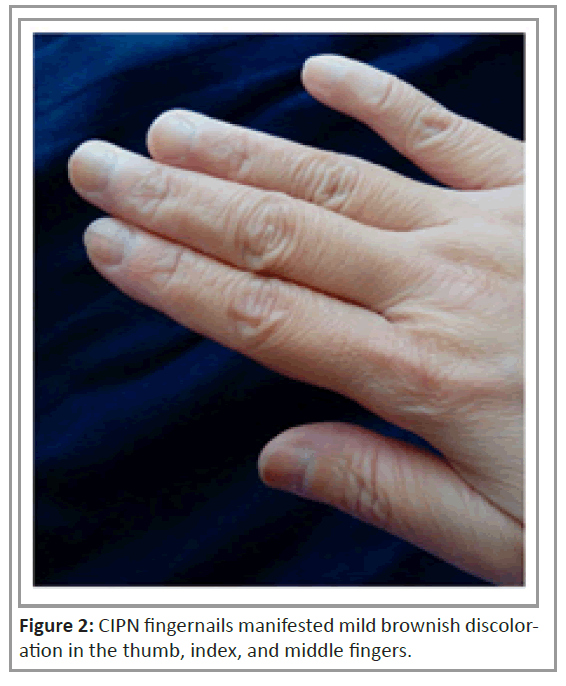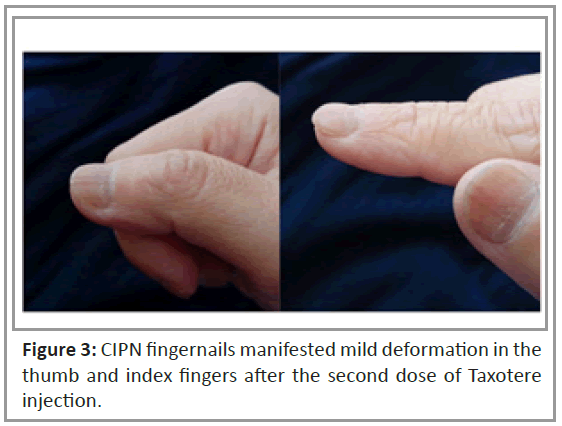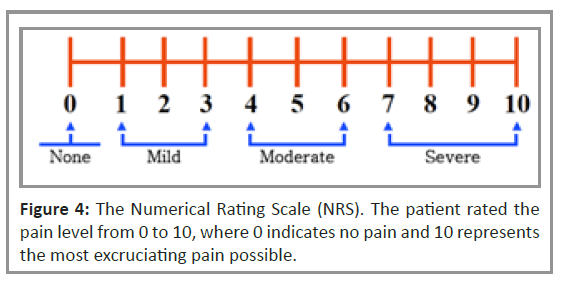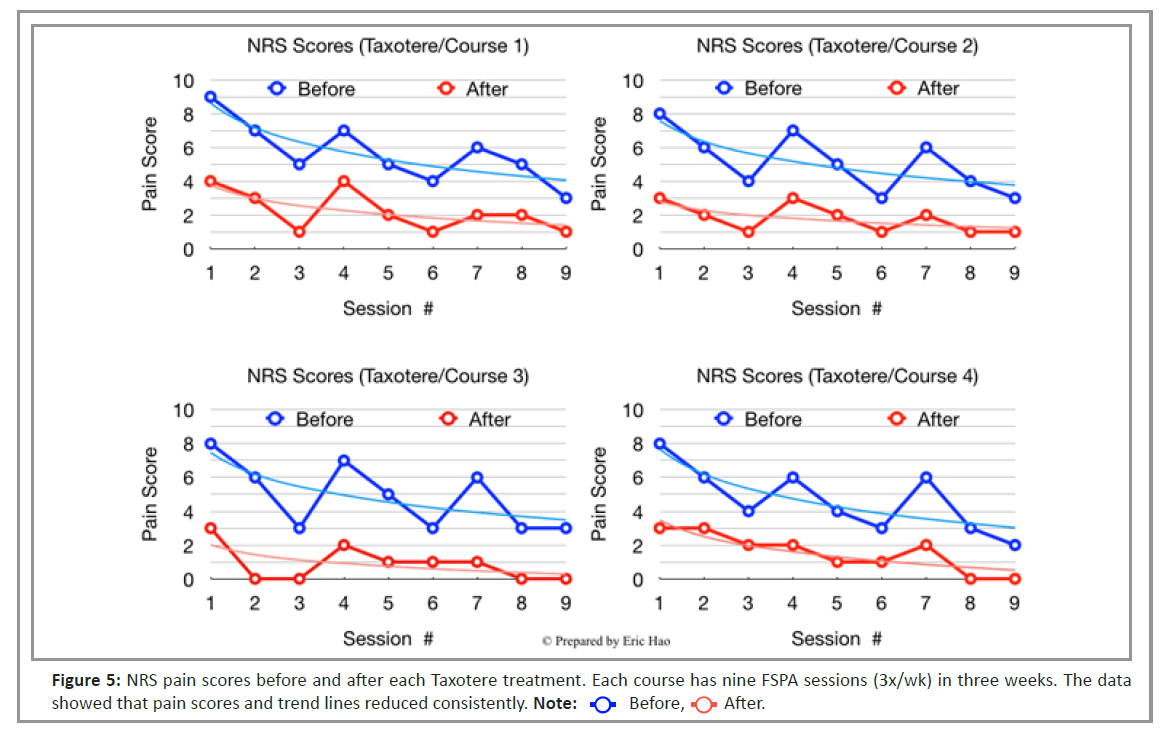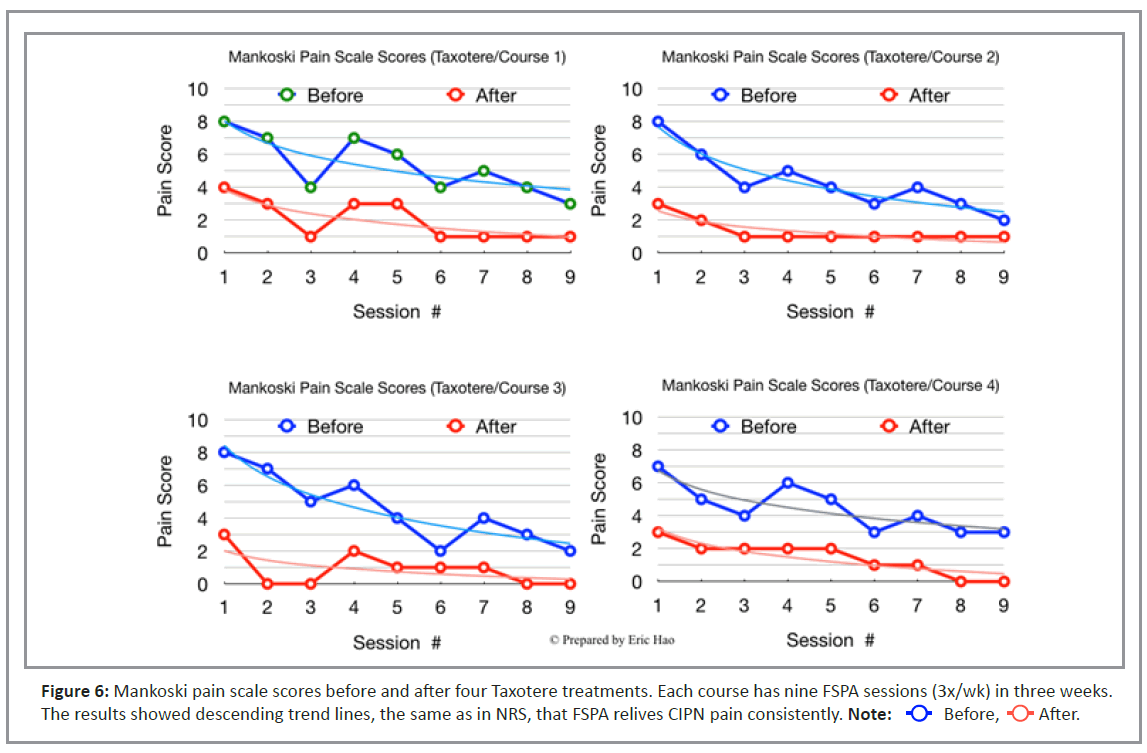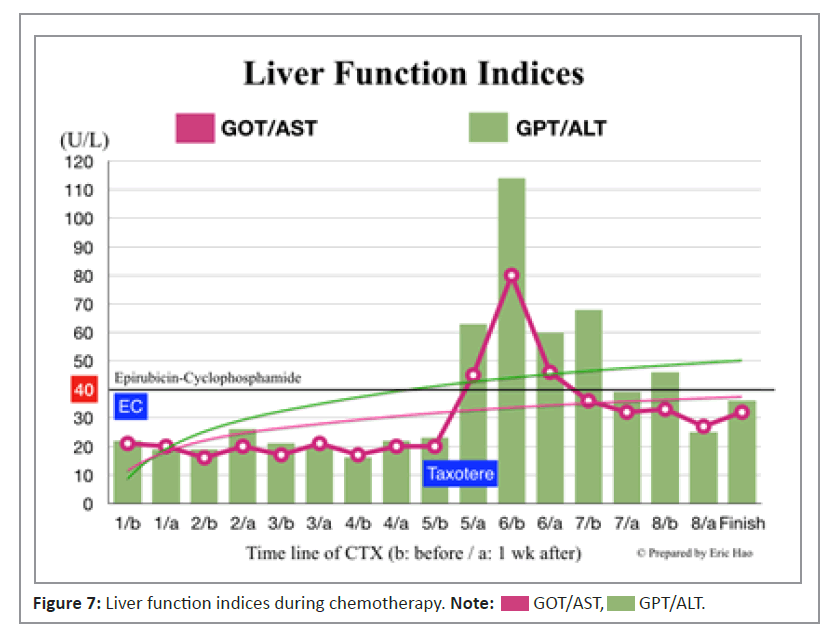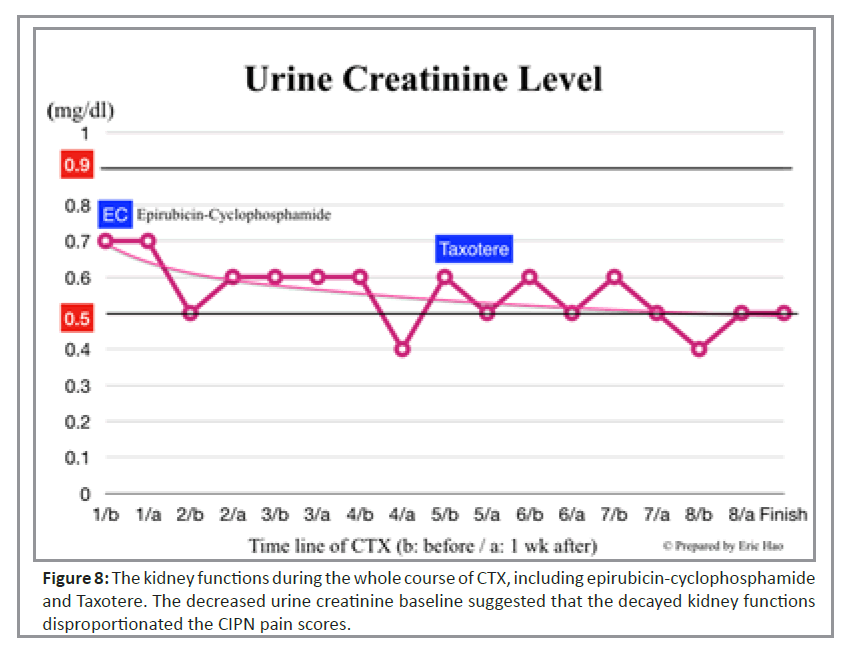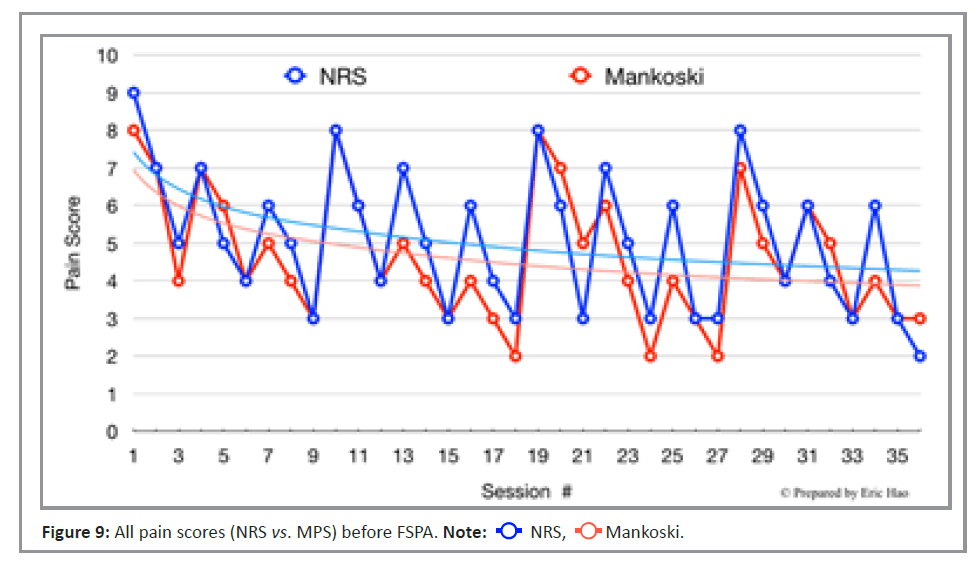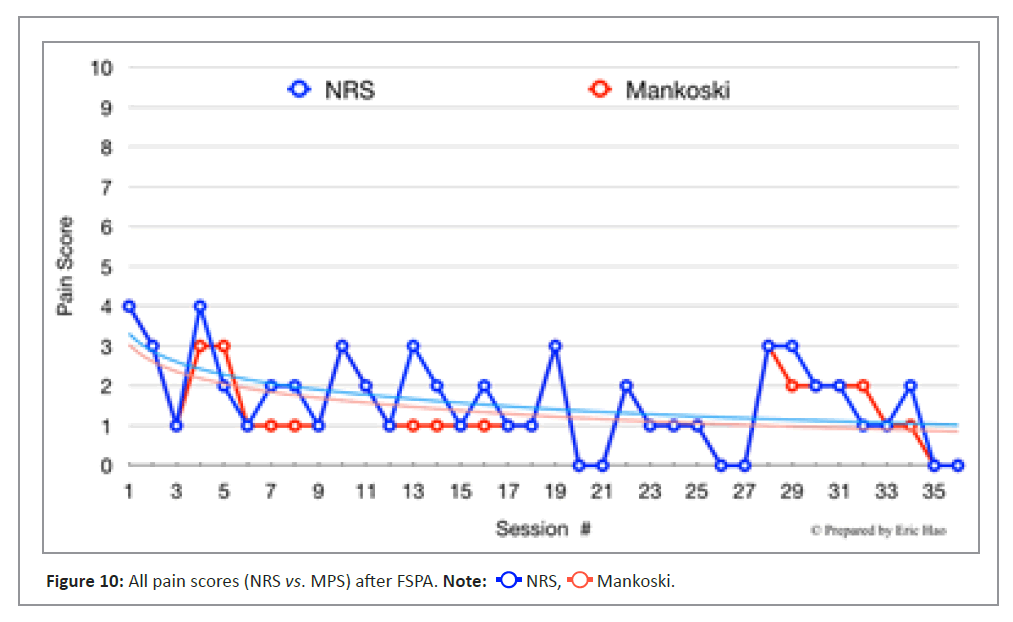New Application of Five Shu-Points for Chemotherapy-Induced Peripheral Neuropathy: A Case Report
Eric Mengchen Hao*
Acupuncture Center for Intractable Pain (ACIP), Taipei City, Taiwan, ROC
- *Corresponding Author:
- Eric Mengchen Hao
Acupuncture Center for Intractable Pain (ACIP), Taipei City, Taiwan,
ROC,
E-mail: acip.ponams@gmail.com
Received date: March 31, 2023, Manuscript No. IPMCRS-23-16272; Editor assigned date: April 05, 2023, PreQC No. IPMCRS-23-16272 (PQ); Reviewed date: April 13, 2023, QC No. IPMCRS-23-16272; Revised date: April 23, 2023; Manuscript No. IPMCRS-23-16272 (R); Published date: April 28, 2023, DOI: 10.36648/2471-8041.9.3.269
Citation: Hao EM (2023) New Application of Five Shu-Points for Chemotherapy-Induced Peripheral Neuropathy: A Case Report. Med Case Rep Vol.9 No.3: 269.
Abstract
Background: Chemotherapy is the primary treatment option for Triple-Negative Breast Cancer (TNBC) due to poor hormonal/target therapy responses. Chemotherapy-Induced Peripheral Neuropathy (CIPN) is one side effect that stops cancer patients from carrying on further management and leaves them with higher cancer recurrence rates, metastasis, and death. However, no known interventions, including traditional acupuncture, have proven consistently efficacious in treating CIPN. The Five Shu-Points Acupuncture (FSPA) location resembles CIPN’s “stocking-glove” manifestation and has been reported effective on diabetic neuropathy. A new FSPA application that implements meridian linkage, tonifying mother and controlling elements, and reducing the son element was introduced to manage CIPN.
Objectives: This report explores the effectiveness of a new FSPA application for CIPN in a TNBC patient.
Materials and Methods: A TNBC patient was treated with FSPA for CIPN on the lung and pericardium meridians in both hands’ thumb, index and middle fingers. SP 3, HT 7, BL 65, 67, LR 3, KI 3, ST 42, and ST 43 were selected and punctured with DBC needles (0.22 mm x 30 mm) three times/week/chemo course for three weeks during four Taxotere administrations. Each session lasts 40 minutes, with re-stimulating each needle for 20 to 30 seconds every 10 minutes under the arrival of Qi (DeQi). The subject recorded the pain level on the numerical rating scale and Mankoski pain scale before and after 36 FSPA sessions. Liver and renal indices were checked to monitor chemo drugs’ cumulative toxicity.
Results: The pain reduction percentage of each FSPA session ranges from 42.86% to 100% on the numerical rating scale and from 50% to 100% on the Mankoski scale. The pain scores dropped to 0-4/10 in both scales, with trend lines presenting consistent pain reduction tendencies, disproportionating chemotherapeutic agents’ cumulative toxicity to the liver and kidney. CIPN symptom-free in the needling sites/meridians were noted.
Conclusions: The data shows that the new FSPA protocol could effectively relieve CIPN in a chemotherapy TNBC patient. The symptom-free areas may imply the FSPA’S preventive capability on the onset of early-stage CIPN. More clinical studies are required to validate the FSPA’s effectiveness.
Keywords
Case report; CIPN; TNBC; Acupuncture; Five shu-points
Abbreviations
BC: Breast Cancer; BL: Bladder (Urinary); CIPN: Chemotherapy-Induced Peripheral Neuropathy; CTX: Chemotherapy; DPN: Diabetic Peripheral Neuropathy; EC-T: Epirubicin-Cyclophosphamide and Taxotere; FSPA: Five Shu- Points Acupuncture; HT: Heart; KI: Kidney; LR: Liver; LU: Lung; MPS: Mankoski Pain Scale; NRS: Numerical Rating Scale; PC: Pericardium; SP: Spleen; ST: Stomach; TNBC: Triple-Negative Breast Cancer
Introduction
Chemotherapy (CTX) is one of the limited therapeutic options besides surgery and radiotherapy for the treatment of Triple- Negative Breast Cancers (TNBC) for its non-responsiveness to hormonal and target therapy [1-5]. Chemotherapeutic agents often cause mild to severe side effects, including but not limited to weakness, nausea, vomiting, hair loss, poor appetite, diarrhea or constipation, low white blood cell count and Chemotherapy- Induced Peripheral Neuropathy (CIPN) [6].
Clinically, most side effects are transient and reversible after CTX is finished. Among those side effects, CIPN is one of the most intractable medical conditions in Breast Cancer (BC) therapy that may lead to temporary or permanent nerve damage, poor quality of life, and prevent patients from receiving continuing curative therapy [7-9].
CIPN is the detriment of peripheral nerves as a result of exposure to chemotherapeutic drugs during cancer treatment [10-13]. Peripheral neuropathy is a group of symptoms that manifest clinically as numbness, tingling, pins and needles sensation, pain and skin hypersensitivity to touch in the fingers and hands or toes and feet below the elbow and knee joints ("stocking-glove" distribution, Figure 1) [14-16] and unsteady gait [17].
CIPN can occur any time after CTX and may worsen as treatment continues [18]. In severe cases, CIPN may cause irreversible nerve damage and contributes to delayed treatment, dose reductions, changes in chemotherapy protocols, or termination of a therapeutic agent [19] that result in an increased rate of mortality, recurrence of cancer, and metastasis of cancer cells to distant organs [20]. The impacts associated with CIPN may give rise to remarkable changes in quality of life, daily routines, professional performances, and even cancer death [21]. A meta-analysis study showed that the prevalence rate of CIPN ranges from 68.1% (first month) to 30% (sixth month) after CTX [22].
To date, no agents or interventions have proven successful in preventing CIPN [23,24]. Furthermore, there is little progress in finding measures to treat CIPN effectively except for symptomatic relief [25,26]. Multiple published articles also showed that various traditional acupuncture protocols, with or without electro-acupuncture, had controversial preventive or therapeutic effects on CPIN [27-32].
Based on the characteristic of the “stocking-glove” distribution of CIPN in hands and feet [33], some articles specifically reported the effectiveness of Five Shu-Points Acupuncture (FSPA) on Diabetic Peripheral Neuropathy (DPN) [34,35]. However, there is no clinical data regarding FSPA as a treatment strategy for CIPN in BC patients. Therefore, exploring an efficient, effective and less side-effect therapy is needed to continue the CTX courses and increase the survival rate in TNBC patients.
This report is the first case using FSPA, instead of other traditional acupuncture techniques, for managing CIPN in a TNBC subject undergoing CTX according to (1) the feature of "stocking-glove" distribution that CIPN shares with FSPA, (2) articles on the FSPA’s effectiveness on diabetic peripheral neuropathy and (3) no clinical data can be found using FSPA as a CIPN treatment protocol on BC patients.
Multiple five-element and acupuncture’s critical fundamentals rarely adapted were implemented to form a new FSPA protocol to substitute the conventional modalities, including meridian linkage, tonify the mother/controlling elements and reducing son elements.
Case Presentation
A 52-year-old Asian female diagnosed with TNBC staging T1N0M0 received a left partial mastectomy followed by eight CTX courses and 30-day radiotherapy.
The chemotherapeutic agents used to treat TNBC were Epirubicin-Cyclophosphamide and Taxotere (EC-T) combination. Epirubicin (85 mg/m2) and cyclophosphamide (600 mg/m2) were given every three weeks in the first four courses, and Taxotere (85 mg/m2) was administered every three weeks for another four courses. Both agents were injected intravenously via a chemo port under the skin. The total time of CTX was 24 weeks.
The subject exhibited no neuropathy symptoms until the second EC injection, after which both hands' thumb, index, and middle fingers manifested mild pins and needles sensation. Upon physical examination, the symptomatic (diseased) meridians involved were the Lung (LU) and Pericardium (PC) meridians at the distal phalanges on both hands, with mild skin hypersensitivity to touch and temperature change. The presenting symptoms exacerbated over time along the EC administration, including disturbances gliding on a cell phone screen, typing/texting, buttoning shirts, mild electrical shock on and off in nails while pinching tiny objects on a flat surface, and sensitivity to temperature/touch/pressure.
The oncologist made the diagnosis of early-stage CIPN. Prednisone 5 mg and vitamin B-complex orally had been prescribed, but the subject stopped taking them due to lack of relief, and no medications have been prescribed since then. After consulting with the oncologist and the author, the new FSPA protocol was launched promptly on the second day of the first Taxotere injection, known for inducing CIPN. After the second dose of Taxotere, mild discoloration (Figure 2) and deformation (Figure 3) in fingernails were noted.
FSPA was introduced three times a week (3X/wk) for three consecutive weeks during Taxotere injections. Nine sessions were carried out for each Taxotere course, with a total of 36 sessions for all four courses of CTX.
Namesake meridian linkages were chosen to guide the symptomatic/diseased meridians to the body’s Yin (ventral or medial) surface for reasons elucidated in the discussion section. With the patient in a supine position, SP 3, HT 7 (contralateral), BL 65, 67 (ipsilateral), LR 3, KI 3 (contralateral) and ST 42, 43 (ipsilateral) were punctured (Table 1) with DBC needles (0.22 mm x 30 mm) to treat CIPN in the thumb, index and middle fingers in both hands, which equivalent to the LU and PC meridians.
| Diseased meridians (Yin) |
Treatment meridian (Namesake) (R*) |
Controlling meridian (T**) |
Mother meridian (T**) |
Son meridian (R*) |
|---|---|---|---|---|
| LU | SP 3 (Yuan/Shu) | HT 7 (Yuan/Shu) | SP 3 (Yuan/Shu) | BL 64 (Yuan) BL 65 (Shu) |
| PC | LR 3 (Yuan/Shu) | KI 3 (Yuan/Shu) | LR 3 (Yuan/Shu) | ST 42 (Yuan) ST 43 (Shu) |
| HT | KI 3 (Yuan/Shu) | KI 3 (Yuan/Shu) | LR 3 (Yuan/Shu) | ST 42 (Yuan) ST 43 (Shu) |
| SP | LU 9 (Yuan/Shu) | LR 3 (Yuan/Shu) | PC 7 (Yuan/Shu) | LI 4 (Yuan) LI 3 (Shu) |
| LR | PC 7 (Yuan/Shu) | LU 9 (Yuan/Shu) | KI 3 (Yuan/Shu) | SI 4 (Yuan) SI 3 (Shu) |
| KI | HT 7 (Yuan/Shu) | SP 3 (Yuan/Shu) | LU 9 (Yuan/Shu) | GB 40 (Yuan) GB 41 (Shu) |
| Note:*R-Reduce, **T-Tonify | ||||
Table 1: New five shu-points protocol's algorithms for CIPN.
Upon needle insertion, the arrival of Qi (DeQi) must be acquired and maintained during the entire acupuncture session to provide a continuous and consistent stimulatory momentum. The tonifying or reducing method is determined by the principles of meridian linkage (reducing for symptomatic relief) and the generating-controlling relationship in the five-element model (tonifying controlling/mother meridians and reducing the son meridian) [36].
The tonifying and reducing methods exercised in this case were inclining needle insertion angles by 6-15 degrees to follow (tonify) or against (reduce) the meridian flow directions [37,38] to achieve the desired manipulation of the meridian. Re-stimulating each needle for 20-30 seconds every 10 minutes using the twist-whirl maneuvering technique [39]. The time of each acupuncture session, from the completion of needle insertion to the removal of all needles, was 40 minutes considering the potentially irreversible nerve damage caused by chemo drugs.
The subject was asked to rate the Numerical Rating Scale (NRS, Figure 4) and the Mankoski Pain Scale (MPS, Table 2) before and after each FSPA session. The NRS pertains to the patient's subjective pain level, while the MPS records a higher specific rating by combining description and corresponding pain numbers. The purposes of incorporating two scales are to verify the coherence of pain scores between scales and to minimize the skewed results.
| Mankoski Pain Scale | ||
|---|---|---|
| 0 | Pain free | No medication needed |
| 1 | Very minor annoyance-occasional minor twinges | No medication needed |
| 2 | Minor annoyance-occasional strong twinges | No medication needed |
| 3 | Annoying enough to be distracting | Mild painkillers are effective. (Aspirin, ibuprofen) |
| 4 | Can be ignored, if you are really involved in your work, but still distracting | Mild painkillers relive pain for 3 to 4 hours |
| 5 | Can’t be ignored for more than 30 minutes | Mild painkillers reduce pain for 3 to 4 hours |
| 6 | Can’t be ignored for any length of time, but you can still go to work and participate in social activities | Stronger painkillers (Codeine, Vicodin) reduce pain for 3 to 4 hours |
| 7 | Makes it difficult to concentrate, interferes with sleep. You can still function with effort | Stronger painkillers are only partially effective. Strongest painkillers relive pain (Oxycotin morphine) |
| 8 | Physical activity severely limited. You can read and converse with effort. Nausea and dizziness set in as factors of pain | Stronger painkillers are minimally effective. Strongest painkillers reduce pain for 3 to 4 hours |
| 9 | Unable to speak. Crying out or moaning uncontrollably-near delirium | Stronger painkillers are only partially effective |
| 10 | Unconscious. Pain makes you pass out | Stronger painkillers are only partially effective |
Table 2: Mankoski Pain Scale (MPS) combines numerical ratings and corresponding descriptions to provide patients and clinicians with a more accurate pain assessment.
Due to the dose-dependent nerve damage caused by chemotherapeutic agents, the liver and kidney functions were measured as indicators to monitor the cumulative toxicity of Taxotere to the subject's system during 36 FSPA sessions.
Results
Before the FSPA session, the highest NRS (Table 3) and MPS (Table 4) scores were 9/10 and 8/10, respectively. The pain score difference between two scales in the same session resulted from the subjective nature of pain reported by the patient NRS, which was fine-tuned in the description-oriented pain scale MPS.
| Week # | Session # | Score (Before) | Score (After) | Pain relief (%) |
|---|---|---|---|---|
| 1 | 1 | 9 | 4 | 55.56 |
| 2 | 7 | 3 | 57.14 | |
| 3 | 5 | 1 | 80 | |
| 2 | 4 | 7 | 4 | 42.86 |
| 5 | 5 | 2 | 60 | |
| 6 | 4 | 1 | 75 | |
| 3 | 7 | 6 | 2 | 66.67 |
| 8 | 5 | 2 | 60 | |
| 9 | 3 | 1 | 66.67 | |
| 4 | 10 | 8 | 3 | 62.5 |
| 11 | 6 | 2 | 66.67 | |
| 12 | 4 | 1 | 75 | |
| 5 | 13 | 7 | 3 | 57.14 |
| 14 | 5 | 2 | 60 | |
| 15 | 3 | 1 | 66.67 | |
| 6 | 16 | 6 | 2 | 66.67 |
| 17 | 4 | 1 | 75 | |
| 18 | 3 | 1 | 66.67 | |
| 7 | 19 | 8 | 3 | 62.5 |
| 20 | 6 | 0 | 100 | |
| 21 | 3 | 0 | 100 | |
| 8 | 22 | 7 | 2 | 71.42 |
| 23 | 5 | 1 | 80 | |
| 24 | 3 | 1 | 66.66 | |
| 9 | 25 | 6 | 1 | 83.33 |
| 26 | 3 | 1 | 66.66 | |
| 27 | 3 | 1 | 66.66 | |
| 10 | 28 | 8 | 3 | 62.5 |
| 29 | 6 | 3 | 50 | |
| 30 | 4 | 2 | 50 | |
| 11 | 31 | 6 | 2 | 66.66 |
| 32 | 4 | 1 | 75 | |
| 33 | 3 | 1 | 66.66 | |
| 12 | 34 | 6 | 2 | 66.66 |
| 35 | 3 | 0 | 100 | |
| 36 | 2 | 0 | 100 |
Table 3: The NRS scores and the pain reduction ratio before and after each FSPA session during the courses of Taxotere CTX.
| Week # | Session # | Score (Before) | Score (After) | Pain relief (%) |
|---|---|---|---|---|
| 1 | 1 | 8 | 4 | 50 |
| 2 | 7 | 3 | 57.14 | |
| 3 | 4 | 1 | 75 | |
| 2 | 4 | 7 | 3 | 57.14 |
| 5 | 6 | 3 | 50 | |
| 6 | 4 | 1 | 75 | |
| 3 | 7 | 5 | 1 | 80 |
| 8 | 4 | 1 | 75 | |
| 9 | 3 | 1 | 66.66 | |
| 4 | 10 | 8 | 3 | 62.5 |
| 11 | 6 | 2 | 66.66 | |
| 12 | 4 | 1 | 75 | |
| 5 | 13 | 5 | 1 | 80 |
| 14 | 4 | 1 | 75 | |
| 15 | 3 | 1 | 66.66 | |
| 6 | 16 | 4 | 1 | 75 |
| 17 | 3 | 1 | 66.66 | |
| 18 | 2 | 1 | 50 | |
| 7 | 19 | 8 | 3 | 62.5 |
| 20 | 7 | 2 | 71.42 | |
| 21 | 5 | 1 | 80 | |
| 8 | 22 | 6 | 2 | 66.66 |
| 23 | 4 | 1 | 75 | |
| 24 | 2 | 1 | 50 | |
| 9 | 25 | 4 | 1 | 75 |
| 26 | 3 | 0 | 100 | |
| 27 | 2 | 0 | 100 | |
| 10 | 28 | 7 | 3 | 57.14 |
| 29 | 5 | 2 | 60 | |
| 30 | 4 | 2 | 50 | |
| 11 | 31 | 6 | 2 | 66.66 |
| 32 | 5 | 2 | 60 | |
| 33 | 3 | 1 | 66.66 | |
| 12 | 34 | 4 | 1 | 75 |
| 35 | 3 | 0 | 100 | |
| 36 | 3 | 0 | 100 |
Table 4: The Mankoski pain scores and pain reduction ratio before and after each FSPA session during the courses of Taxotere CTX.
After FSPA treatment, the pain reduction percentage of each FSPA session ranges from 42.86% to 100% in NRS (Table 3) and from 50% to 100% in MPS (Table 4). In addition, the pain scores dropped to 0-4/10 in both NRS (Figure 5) and MPS (Figure 6), respectively, with trend lines presenting constant pain reduction tendencies.
Figures 5 and 6 also illustrate the overall pain scores and the trend of pain level reduction in both scales. The results showed again that the trend lines sloped down progressively and consistently after FSPA management from 4.3-7.4/10 to 1.1- 3.2/10 in NRS (Figure 5) and from 4.9-6.9/10 to 0.9-3.0/10 in MPS (Figure 6).
In order to further support the pain relief effects of FSPA, both the indices and trend lines of liver and kidney functions were monitored as the baseline of Taxotere’s cumulative toxicity to the system. Figures 7 and 8 presented that liver and kidney functions progressively deteriorated during the eight courses of CTX. However, the consistently slopped-down pain scores in Figures 5 and 6 disproportionated with the Taxotere’s cumulative toxicity.
Figures 9 and 10 illustrate the overall trend of FSPA’s pain reduction tendency in NRS and MPS, respectively. The pain score difference between two trend lines in the same FSPA session was less than 0.5/10 before and after FSPA treatment and remained parallel decreasing. Both the scales used in this report can provide reliable data for statistical analysis when extensive sample-size studies are conducted.
Discussion
Due to conventional medicine’s limited progress and the controversial outcomes of traditional acupuncture in managing CIPN, this case report attempted to formulate a practical protocol by inspecting and integrating the fundamentals of TCM, acupuncture and meridian theory.
Considerations of acupuncture meridian linkage
As seen in Table 1, the Namesake meridian linkage chosen to treat symptomatic LU and PC meridians was on the body’s Yin surfaces. From a clinical’s perspective, there are three practical reasons for linking all the diseased meridians to Yin treatment meridians.
Firstly, the supine position is better tolerated by most physically compromised and weak constitution individuals, e.g., cancer patients during/after CTX, than the prone or sitting position when receiving acupuncture treatment.
Secondly, a relaxed anatomical supine position naturally exposes more Yin than the Yang (dorsal or lateral) surfaces of the body and limbs. In CIPN patients with symptoms localized in fingers, the five shu-points on the linked Yin treatment meridians are away from either symptomatic areas or meridians to avoid triggering unnecessary additional pain during needle insertion.
Thirdly, when managing painful disorders, Shu-stream points are the most indicated points for their actions of relieving joint pain and body heaviness. When detouring a diseased meridian to a Yin treatment meridian, Shu-stream and Yuan-source points are identical and share the same five-element attribution. The Yuan-source point is a universal point on each meridian that can be used in various syndromes, including excess, deficiency, cold and heat. Needling Shu-stream and Yuan-source point on a Yin meridian simultaneously will generate significantly amplified momentum to induce additional therapeutic effects [40].
The primary concern about using exterior-interior treatment meridians, one meridian linkage option not chosen in this case, would be the proximity of acupuncture points to the painful areas and the possibility of needling the pain spots during treatment unless the clinical symptoms manifested otherwise.
Application of tonifying/reducing methods
One of the contributing factors to the success of intractable pain management is identifying the excess-deficiency nature and introducing appropriate tonifying and reducing methods accordingly. It is equally important to manage symptoms and the cause while treating intractable pain. The protocols listed in Table 1 have included the strategies of symptomatic relief by reducing the linked treatment meridians, tonifying controlling meridians and reducing son meridians. At the same time, cause management is accomplished by tonifying mother meridians.
The tonifying and reducing methods employed are to adjust the needling angle to follow or against the meridian flow for the following reasons. (1) The inclined needles may generate constant tonifying or reducing effects. (2) The sloped insertion provides a clear and specific visual clarification when re-stimulation is exercised. Other tonifying-reducing methods, such as lift-thrust, respiration and rapid-slow, may be exercised to practitioners' preferences and experiences.
In this case, tonification and reduction are associated with the excess or deficiency of pain and the Yin-Yang attribution of the selected treatment meridians. Danxi Zhu, a famous TCM doctor in Yuan Dynasty, proposed a well-known and widespread physiological phenomenon regarding the human body: “Yang tends to be excess whereas Yin tends to be deficient” [41]. By adopting this doctrine to CIPN management, tonifying Yin meridians and reducing Yang meridians become the principal guideline unless indicated otherwise. However, as a symptom, the pain itself is considered an excess that needs to be reduced. The cause of the pain can be either an excess or a deficiency that requires a corresponding reducing or tonifying method, respectively.
Incorporating TCM and five-element fundamentals
When treating CIPN, due to its intractability and possible irreversibility of sensory and motor dysfunctions that impact patients' quality of life, TCM and acupuncture fundamental principles were required to enhance the FSPA's pain relief effect.
The generating-controlling relationship is an essential foundational basis of the law of nature in TCM. It interprets the dynamic balance among Zang-Fu organs, their interactions, and how diseases occur, change and treatment. Implementing this supreme synergy among elements, suppressing the excess and replenishing the deficiency drive the body's systemic balance-restoring process quickly and powerfully from the root.
The critical fundamental of TCM and acupuncture theory that "tonifying the mother-element to treat deficiencies and reducing the son-element to treat excess." Guides a portion of acupuncture protocol formation in this case. It manages disorders based on the excess-deficiency nature identified by syndrome differentiation. The therapeutic success was well-demonstrated and substantially elevated when the correct diagnosis was reached and technical fundamentals were adequately practiced.
As seen in Table 1, a controlling meridian, a mother meridian and a son meridian are the combined treatment meridians used in the new FSPA protocol. Therefore, using Yuan-source and Shu- stream points with their actions to either regulate the overall energetic status of a meridian or target pain specifically, CIPN pain management can be appropriately addressed.
Interpretation of five shu-points effects
Shu-stream points are the best choice when treating painful disorders for their actions on joint pain and body heaviness. The other point used in this report is the Yuan-source point, whose action is to act on the entire meridian for all indications, including the excess, deficiency, heat and cold syndromes.
By combining the Yuan-source point’s “universal” action and a Shu-stream point, the integrative potency of meridian regulation is greatly enhanced due to either the proximity of the two points on a Yang meridian or sharing the exact point location on a Yin meridian. Furthermore, the additional momentum driven by combining two to three adjacent points on a meridian can generate more substantial unblocking efficacy in restoring the free flow of Qi and blood [40].
Besides the significant pain relief effect of the new FSPA protocol, the subject did not exhibit CIPN symptoms in her ring finger, pinky in both hands and all the toes. One of the explanations for the lack of the same stocking-glove distribution as other sufferers is that the symptoms manifested exclusively in three fingers when CIPN had developed. Another probable reason is the preventive effect of needling local/regional points on a symptom-free meridian.
Table 1 lists the HT meridian in hands and all the six Yin and Yang meridians in feet as the treatment meridians. Therefore, the probability of preventive effects delivered by needling regional or local five Shu-points on asymptomatic meridians must rule out by conducting clinical trials focusing on the preventive effects of FSPA on CIPN.
During the entire FSPA sessions, the symptomatic fingers and fingernails remain mild neuropathic pain and deformities, respectively, without worsening further. It is assumed that the earlier the beginning of FSPA intervention, the milder the symptom progression and the better the prognosis.
FSPA session
The designated treatment time in this report is 40 minutes, three times per week for 12 weeks (excluding the time for intake, physical examination, patient and skin preparation, removal of needles and pain scale rating/recording), which is longer and more frequent than most of the reviewed acupuncture articles. The main reasons for such a study design are based on the following facts to assure and strengthen FSPA’S pain relief effect: (1) CIPN is an intractable painful disorder that responds diversely to acupuncture treatment protocols with uncertain success. (2) CIPN is a form of nerve damage with a slower regenerating rate in a cancer patient than in healthy subjects [42,43]. (3) Patients' weak constitution may delay the restoration of the free flow of meridians.
Conclusion
This report indicates that the new FSPA application is an evidence-based and potentially valuable therapeutic modality for managing CIPN in TNBC patients and can be included in the treatment protocols of others. The lack of CIPN symptoms in the rest of the fingers and toes suggested that FSPA might deliver the preventive effects on the onset of CIPN and other types of neuropathic pain. The launch of FSPA treatment in a timely fashion reduces/prevent the clinical progression of CIPN. A more extensive scale of clinical trials must be conducted to validate the effectiveness of FSPA’s preventive and therapeutic effects on CIPN.
Declaration
Ethics approval and consent to participate
The subject participated voluntarily and provided her informed consent form after reading it and being explained. All procedures performed in this report were in accordance with the ethical standards of and with the 1964 Helsinki declaration and its later amendments or comparable ethical standards.
Consent for publication
The author confirms the written consent for publication, including clinical data, laboratory results, figures and tables, which were viewed and signed before submission and obtained from the study participant.
Availability of data and materials
All the papers cited in this article can be found on MedlinePlus, PubMed, Google Scholar, EBSCO, associate websites and books at the end of each reference, either through hyperlinks or DOIs. The data recorded or analyzed during the management are included.
Competing Interests and Funding
The author declares no conflict of interest of any form, financially or non-financially in nature, that could appear to influence the outcome presented in this article.
Funding
The author declares this report received no funding of any form from any party in the public, private, or not-for-profit sectors.
Authors' Contributions
The sole author, MH, is fully responsible for the paper review, experiment design, clinical procedure execution, clinical data collection, interpretation of outcomes and manuscript preparation and composing. MH declares and confirms the originality of all images and tables.
Acknowledgment
This research was conducted and accomplished under the full cooperation of the TNBC patient, Mrs. Chang. We thank her for volunteering and supporting completing the clinical case report.
References
- Baranova A, Krasnoselskyi M, Starikov V, Kartashov S, Zhulkevych I, et al. (2022) Triple-negative breast cancer: Current treatment strategies and factors of negative prognosis. J Med Life 15: 153–161.
[Crossref], [Google Scholar], [Indexed]
- Li Y, Zhang H, Merkher Y, Chen L, Liu N, et al. (2022) Recent advances in therapeutic strategies for triple-negative breast cancer. J Hematol Oncol 15: 121.
[Crossref], [Google Scholar], [Indexed]
- Jitariu AA, Cimpean AM, Ribatti D, Raica M (2017) Triple negative breast cancer: The kiss of death. Oncotarget 8: 46652–46662.
[Crossref], [Google Scholar], [Indexed]
- Chalakur-Ramireddy NKR, Pakala SB (2018) Combined drug therapeutic strategies for the effective treatment of triple negative breast cancer. Bioscience reports 38: BSR20171357.
[Crossref], [Google Scholar], [Indexed]
- Bianchini G, Balko JM, Mayer IA, Sanders ME, Gianni L (2016) Triple-negative breast cancer: Challenges and opportunities of a heterogeneous disease. Nat Rev Clin Oncol 13: 674–690.
[Crossref], [Google Scholar], [Indexed]
- https://www.cancer.org/treatment/treatments-and-side-effects/treatment-types/chemotherapy/chemotherapy-side-effects.html.
- Ibrahim EY, Ehrlich BE (2020) Prevention of chemotherapy-induced peripheral neuropathy: A review of recent findings. Crit Rev Oncol Hematol 145: 102831.
[Crossref], [Google Scholar], [Indexed]
- Cavaletti G, Alberti P, Marmiroli P (2015) Chemotherapy-induced peripheral neurotoxicity in cancer survivors: An underdiagnosed clinical entity? Am Soc Clin Oncol Educ Book 35: e553–e560.
[Crossref], [Google Scholar], [Indexed]
- Miaskowski C, Mastick J, Paul SM, Topp K, Smoot B (2017) Chemotherapy-induced neuropathy in cancer survivors. J Pain Symptom Manage 54: 204–218.
[Crossref], [Google Scholar], [Indexed]
- Avan A, Postma TJ, Ceresa C, Avan A, Cavaletti G, et al. (2015) Platinum-induced neurotoxicity and preventive strategies: Past, present and future. Oncologist 20: 411–432.
[Crossref], [Google Scholar], [Indexed]
- Kim JH, Dougherty PM, Abdi S (2015) Basic science and clinical management of painful and non-painful chemotherapy-related neuropathy. Gynecol Oncol 136: 453–459.
[Crossref], [Google Scholar], [Indexed]
- Schloss J, Colosimo M, Vitetta L (2016) New insights into potential prevention and management options for chemotherapy-induced peripheral neuropathy. Asia Pac J Oncol Nurs 3: 73–85.
[Crossref], [Google Scholar], [Indexed]
- Brewer JR, Morrison G, Dolan ME, Fleming GF (2016) Chemotherapy-induced peripheral neuropathy: Current status and progress. Gynecol Oncol 140: 176-83.
[Crossref], [Google Scholar], [Indexed]
- Jaggi AS, Singh N (2012) Mechanisms in cancer-chemotherapeutic drugs-induced peripheral neuropathy. Toxicology 291: 1-9.
[Crossref], [Google Scholar], [Indexed]
- Schneider BP, Hershman DL, Loprinzi C (2015) Symptoms: Chemotherapy-induced peripheral neuropathy. Adv Exp Med Biol 862: 77-87.
[Crossref], [Google Scholar], [Indexed]
- Colvin LA (2019) Chemotherapy-induced peripheral neuropathy: Where are we now? Pain 160: S1–S10.
[Crossref], [Google Scholar], [Indexed]
- Duregon F, Vendramin B, Bullo V, Gobbo S, Lucia C, et al. (2017) Effects of exercise on cancer patients suffering chemotherapy-induced peripheral neuropathy undergoing treatment: A systematic review. Crit Rev Oncol Hematol 121: 90-100.
[Crossref], [Google Scholar], [Indexed]
- Staff NP, Grisold A, Grisold W, Windebank AJ (2017) Chemotherapy-induced peripheral neuropathy: A current review. Ann Neurol 81: 772–781.
[Crossref], [Google Scholar], [Indexed]
- Seretny M, Currie GL, Sena ES, Ramnarine S, Grant R, et al. (2014) Incidence, prevalence and predictors of chemotherapy-induced peripheral neuropathy: A systematic review and meta-analysis. Pain 155: 2461–2470.
[Crossref], [Google Scholar], [Indexed]
- Yao H, He G, Yan S, Chen C, Song L, et al. (2017) Triple-negative breast cancer: Is there a treatment on the horizon? Oncotarget 8: 1913–1924.
[Crossref], [Google Scholar], [Indexed]
- Iżycki D, Niezgoda AA, Kaźmierczak M, Piorunek T, Iżycka N, et al. (2016) Chemotherapy-induced peripheral neuropathy-diagnosis, evolution and treatment. Ginekol Pol 87: 516–521.
[Crossref], [Google Scholar], [Indexed]
- Addington J, Freime M (2016) Chemotherapy-induced peripheral neuropathy: An update on the current understanding. F1000Res 5: 1466.
[Crossref], [Google Scholar], [Indexed]
- Grisold W, Cavaletti G, Windebank AJ (2012) Peripheral neuropathies from chemotherapeutics and targeted agents: Diagnosis, treatment and prevention. Neuro Oncol 14: iv45–iv54.
[Crossref], [Google Scholar], [Indexed]
- Loprinzi CL, Lacchetti C, Bleeker J, Cavaletti G, Chauhan C, et al. (2020) Prevention and management of chemotherapy-induced peripheral neuropathy in survivors of adult cancers: ASCO guideline update. J Clin Oncol 38: 3325–3348.
[Crossref], [Google Scholar], [Indexed]
- Majithia N, Loprinzi CL, Smith TJ (2016) New practical approaches to chemotherapy-induced neuropathic pain: Prevention, assessment and treatment. Oncology 30: 1020-9.
[Google Scholar], [Indexed]
- Maihöfner C, Diel I, Tesch H, Quandel T, Baron R (2021) Chemotherapy-Induced Peripheral Neuropathy (CIPN): Current therapies and topical treatment option with high-concentration capsaicin. Support Care Cancer 29: 4223–4238.
[Crossref], [Google Scholar], [Indexed]
- Donald GK, Tobin I, Stringer J (2011) Evaluation of acupuncture in the management of chemotherapy-induced peripheral neuropathy. Acupunct Med 29: 230-233.
[Crossref], [Google Scholar], [Indexed]
- Jeong YJ, Kwak MA, Seo JC, Park SH, Bong JG, et al. (2018) Acupuncture for the treatment of taxane-induced peripheral neuropathy in breast cancer patients: A pilot trial. Evid Based Complement Alternat Med 2018: 5367014.
[Crossref], [Google Scholar], [Indexed]
- Greenlee H, Crew KD, Capodice J, Awad D, Buono D, et al. (2016) Randomized sham-controlled pilot trial of weekly electro-acupuncture for the prevention of taxane-induced peripheral neuropathy in women with early stage breast cancer. Breast Cancer Res Treat 156: 453–464.
[Crossref], [Google Scholar], [Indexed]
- Wong R, Major P, Sagar S (2016) Phase 2 study of acupuncture-like transcutaneous nerve stimulation for chemotherapy-induced peripheral neuropathy. Integr Cancer Ther 15: 153–164.
[Crossref], [Google Scholar], [Indexed]
- Lu W, Giobbie-Hurder A, Freedman RA, Shin IH, Lin NU, et al. (2020) Acupuncture for chemotherapy-induced peripheral neuropathy in breast cancer survivors: A randomized controlled pilot trial. Oncologist 25: 310–318.
[Crossref], [Google Scholar], [Indexed]
- Kutcher AM, LeBaron VT (2022) Evaluating acupuncture for the treatment of chemotherapy-induced peripheral neuropathy: An integrative review. West J Nurs Res 44: 169–179.
[Crossref], [Google Scholar], [Indexed]
- Sphar BG, Bowe C, Dains JE (2020) The impact of peripheral cooling on chemotherapy-induced peripheral neuropathy: An integrative review. J Adv Pract Oncol 11: 845–857.
[Crossref], [Google Scholar], [Indexed]
- Yuan HT (2006) Acupuncture at five Shu points for treatment of 126 cases of numbness of hands and feet induced by peripheral diabetic neuropathies. Zhongguo Zhen Jiu 26: 225-6.
[Google Scholar], [Indexed]
- Shu W, Ran JC, Chen BL, Li CN, Ruan SQ, et al. (2021) Acupuncture at xing-spring point, Shu-stream point and lower he-sea point for type-2 diabetic peripheral neuropathy. Zhongguo Zhen Jiu 41: 866–870.
[Crossref], [Google Scholar], [Indexed]
- Young WC (2010) Zhen Jiu Bao Dian. American Chinese Medical Culture Center: Mu Zi Bu Xie Fa. (2nd edition) Rowland heights, USA: 74-78.
- Cheng XN (1987) Chinese acupuncture and moxibustion: Tonifying and reducing methods. (1st edition) Foreign language press, Beijing, China: p327-329.
- Young WC (2010) Zhen Jiu Bao Dian. American Chinese Medical Culture Center: Ying Sui Bu Xie Fa. (2nd edition) Rowland heights, USA: 64-65.
- Young WC (2010) Zhen Jiu Bao Dian. American Chinese Medical Culture Center: Nian Zhuan Bu Xie Fa. (2nd edition) Rowland heights, USA: 64-65.
- Young WC (2010) Zhen Jiu Bao Dian. American Chinese Medical Culture Center: Dao Ma Zhen Fa. (2nd edition) Rowland heights, USA: 95-97.
- https://ndltd.ncl.edu.tw/cgi-bin/gs32/gsweb.cgi?o=dnclcdr&s=id=%22102CMCH5050004%22.&searchmode=basic
- Polydefkis M, Hauer P, Sheth S, Sirdofsky M, Griffin JW, et al. (2004) The time course of epidermal nerve fibre regeneration: Studies in normal controls and in people with diabetes, with and without neuropathy. Brain 127: 1606–1615.
[Crossref], [Google Scholar], [Indexed]
- Magge RS, DeAngelis LM (2015) The double-edged sword: Neurotoxicity of chemotherapy. Blood Rev 29: 93–100.
[Crossref], [Google Scholar], [Indexed]

Open Access Journals
- Aquaculture & Veterinary Science
- Chemistry & Chemical Sciences
- Clinical Sciences
- Engineering
- General Science
- Genetics & Molecular Biology
- Health Care & Nursing
- Immunology & Microbiology
- Materials Science
- Mathematics & Physics
- Medical Sciences
- Neurology & Psychiatry
- Oncology & Cancer Science
- Pharmaceutical Sciences
